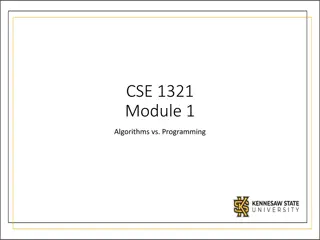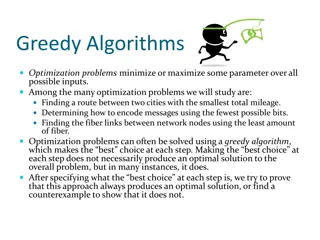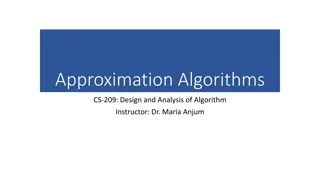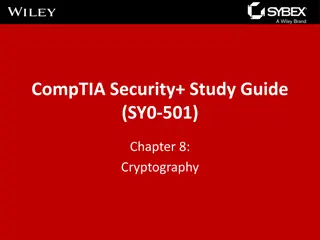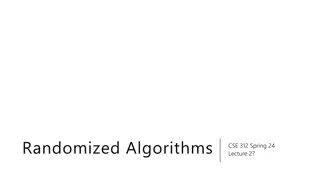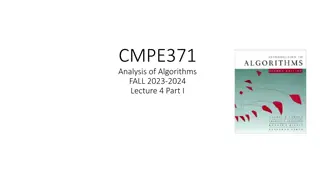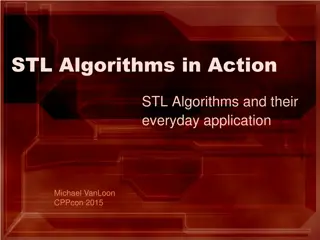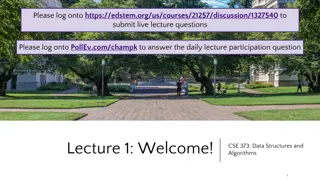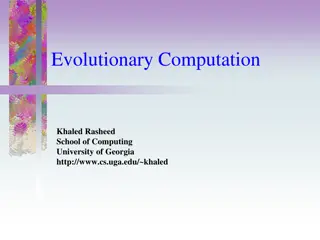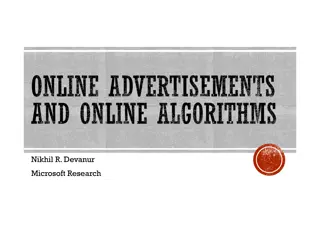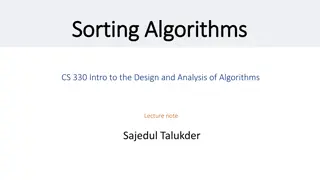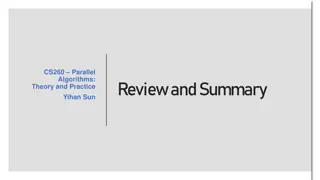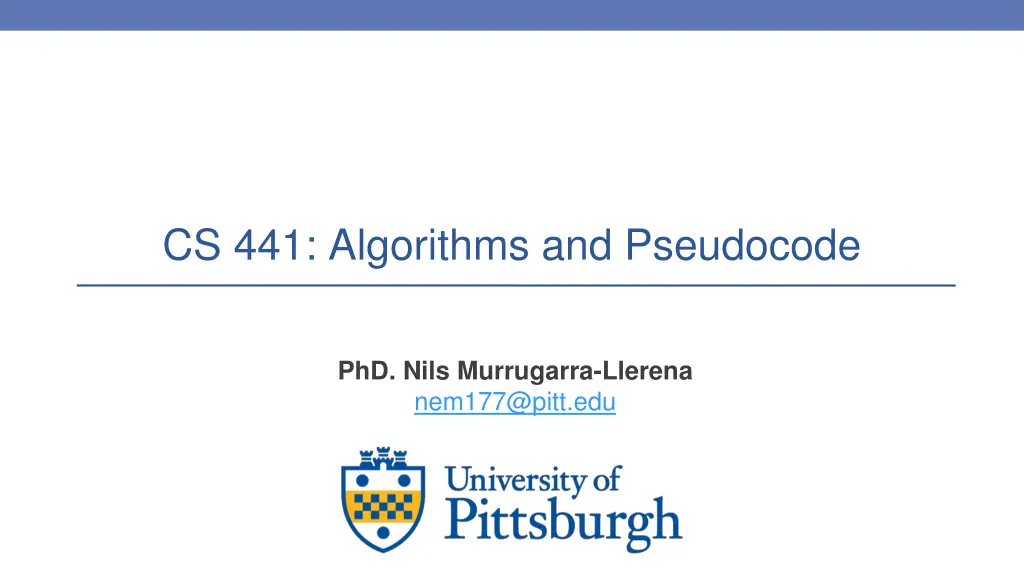
Understanding Algorithms and Pseudocode for Problem Solving
Explore the concepts of algorithms, pseudocode, and problem-solving techniques in computer science. Learn about the essential features of algorithms, defining problems, and solving strategies through examples like sorting and searching. Gain insights into formulating precise instructions and sequences to efficiently solve computational problems.
Download Presentation

Please find below an Image/Link to download the presentation.
The content on the website is provided AS IS for your information and personal use only. It may not be sold, licensed, or shared on other websites without obtaining consent from the author. If you encounter any issues during the download, it is possible that the publisher has removed the file from their server.
You are allowed to download the files provided on this website for personal or commercial use, subject to the condition that they are used lawfully. All files are the property of their respective owners.
The content on the website is provided AS IS for your information and personal use only. It may not be sold, licensed, or shared on other websites without obtaining consent from the author.
E N D
Presentation Transcript
CS 441: Algorithms and Pseudocode PhD. Nils Murrugarra-Llerena nem177@pitt.edu
2 Today's topics Algorithms and pseudocode What is an algorithm? Pseudocode allows us to describe an algorithm in a semi- structured way Algorithms for basic problems
3 What is an algorithm? Definition: An algorithm is a finite sequence of precise instructions for solving a problem Note these important features! Finite: In order to execute, it must be finite Sequence: The steps needs to be in the correct order Precise: Each step must be unambiguous Instructions: Each step can be carried out Solving a problem: ?
4 What is a problem? A problem should be general enough to be broadly useful, but specific enough to dictate strategies Sort the numbers (6, 8, 5, 3) is too specific; let s allow the input to be specified Return the numeric solution to the input query is too general; different instances may not be solved similarly In computing, we usually represent a problem using its desired solutions Inputs: What is provided to identify the instance of the problem? Outputs: What are the correct outputs for each input?
5 An example problem: Sorting Sorting: Put the provided values in ascending order Input: A sequence of numeric values ?? Output: A sequence ?? containing the same elements as ??, arranged such that ?,? ? < ? ??< ?? If we specify the input(s), we create an instance of the problem We consider each input sequence to be one instance of the more general problem, not a different problem A solution to an instance is an output that corresponds to the input Could a problem instance have multiple correct outputs?
6 The searching problem Intuition: Given a list, find a specific element (if possible) How would you solve this? To help with describing a solution, let s assign our inputs to have variable names that we can refer to, and describe the desired output more precisely Problem: Given a sequence of values a1, a2, , an, and a target value, x, return an index i such that ai= x (or 0 if no such index exists) One possible algorithm to solve this: Compare each aito x, starting from a1and proceeding sequentially. Return the first i which yields ai= x.
7 Search: Example Example: Search 19 in the list: 1 2 3 5 6 7 8 10 12 13 15 16 18 19 20 22 Position: Values: 1 2 3 4 5 6 7 8 9 10 11 12 13 14 15 16 1 2 3 5 6 7 8 10 12 13 15 16 18 19 20 22 19 7
8 Pseudocode provides a structured way to represent an algorithm If we start describing a way to solve sorting, it may not feel very precise Examples? Pseudocode is a semi-structured set of notations More precise than describing in prose Less overhead than a programming language Compare to proof techniques A formal proof is analogous to a program in (say) Java Meant to be executed by a machine, very precise An informal proof is analogous to an algorithm in pseudocode Meant to be understood by a human, so steps can be abstracted. Different communities may prefer different conventions.
9 An algorithm for the searching problem Algorithm name Input variables Input data types procedure linear search(x: integer, a1, a2, , an: distinct integers) i := 1 while (i n and x ai) i := i + 1 if i n then location := i else location := 0 return location {location is the subscript of the term that equals x, or is 0 if x is not found} Return the solution Assigning a variable Repetition structure Selection structure Comment (exposition; no effect)
10 Selection structure executes instructions conditionally if condition then statement 1 else statement 2 optional else case if condition then statement 1 statement 2 statement n statement n+1 multiple conditional statements statements after are always executed if condition 1 then statement 1 else if condition 2 then statement 2 else if condition n then statement n else statement n+1 mutually-exclusive cases
11 Repetition structure executes instructions multiple times for variable := initial value to final value statement for-loop: execute statement(s) for each value in a sequence while condition statement sum := 0 for i := 1 to n sum := sum + i variable is assumed to update automatically for each iteration sum := 0 i := 1 while i n sum := sum + i i := i + 1 while-loop: if condition is true, execute statement(s), then check again statements must update variable(s) to make condition false
12 In-class exercises Problem 1: Consider a version of the search problem where the sequence to search is in sorted order. Write an updated version of the linear search algorithm that stops searching once it is determined that the target element is not present. Problem 2: What is the output of this algorithm given input 100? procedure problem 2(t: integer) x := 1 while (x t) x := x * 2 return x
13 More efficient approaches to searching? If the input is sorted, we can implement an even faster search Binary search, main idea Track an interval within the sequence where the target must be Initially set to the entire sequence Divide the interval in half and determine whether the target would be in the left or right half Repeat until the item is found or the interval is empty 3 6 11 18 22 26 32 40 52 55 58 60 64 68 77 80 Search for 64
14 Binary search, pseudocode procedure binary search(x: integer, a1, a2, , an: integers in non- decreasing order) start := 1 end := n while start < end mid := (start + end) / 2 if x > amidthen start := mid + 1 else if x < amidthen end := mid 1 else start := mid end := mid if x = astartthen location := start else location := 0 return location
Binary search: Example Example: The steps taken by a binary search for 19 in the list: 1 2 3 5 6 7 8 10 12 13 15 16 18 19 20 22 1. The list has 16 elements, so the midpoint is 8. The value in the 8thposition is 10. Since 19 > 10, further search is restricted to positions 9 through 16. Position: 1 2 3 4 5 6 7 8 9 10 11 12 13 14 15 16 Values: 1 2 3 5 6 7 8 10 12 13 15 16 18 19 20 22 2. The midpoint of the list (positions 9 through 16) is now the 12thposition with a value of 16. Since 19 > 16, further search is restricted to the 13thposition and above. Position: 1 2 3 4 5 6 7 8 9 10 11 12 13 14 15 16 Values: 1 2 3 5 6 7 8 10 12 13 15 16 18 19 20 22 15
Binary search: Example 3. The midpoint of the current list is now the 14thposition with a value of 19. Since 19 19, further search is restricted to the portion from the 13ththrough the 14thpositions . Position: 1 2 3 4 5 6 7 8 9 10 11 12 13 14 15 16 Values: 1 2 3 5 6 7 8 10 12 13 15 16 18 19 20 22 4. The midpoint of the current list is now the 13thposition with a value of 18. Since 19> 18, search is restricted to the portion from the 14thposition through the 14th. Position: 1 2 3 4 5 6 7 8 9 10 11 12 13 14 15 16 Values: 1 2 3 5 6 7 8 10 12 13 15 16 18 19 20 22 5. Now the list has a single element and the loop ends. Since 19=19, the location 14 is returned. 16
17 Let s revisit a problem we specified earlier Sorting: Put the provided values in ascending order Input: A sequence of numeric values ?? Output: A sequence ?? containing the same elements as ??, arranged such that ? ? < ? ??< ?? Bubble sort, intuition When comparing two adjacent elements, they should be relatively sorted (if not, let s swap interchange them) Traverse the sequence left to right, swapping whenever necessary Repeat as many times as necessary How many times?
18 Bubble Sort: Example Example: Show the steps of bubble sort with 3 2 4 1 5 At the first pass the largest element has been put into the correct position At the end of the second pass, the 2ndlargest element has been put into the correct position. In each subsequent pass, an additional element is put in the correct position. McGraw Hill
19 Bubble sort pseudocode procedure bubble sort(a1, a2, , an: real numbers) for i := 1 to n-1 for j := 1 to n-1 if aj> aj+1then swap ajand aj+1 Do we need to go all the way to the end? Any optimizations? Inner loop stopping value: Consider how much progress we can guarantee from each pass Outer loop responsive termination: Might we finish sorting before i = n-1?
20 Specific types of problems and algorithms Definition: An optimization problem is a problem in which the goal is to find the solution (among a set of possible solutions) that maximizes or minimizes the value of some parameter Examples: Given the locations of a set of cities, what visitation order minimizes total travel? (Traveling salesperson problem) Given an amount of change, what denominations should be given to minimize the number of coins? (Change-making problem) Given an actor, what is the minimum number of hops (each to an actor that appeared with the previous in some movie) to arrive at Kevin Bacon?
21 One strategy for optimization problems: Greedy algorithms Definition: A greedy algorithm is an algorithm that makes what seems to be the best choice at each step while iteratively constructing a solution. A greedy approach to change-making: At each step, select the greatest denomination that can fit within the remaining change to give A greedy approach to traveling salesperson: At each step, visit the (unvisited) city closest to your current location Note that, depending on the problem, a greedy algorithm might not find the optimal solution!
22 Cashier s algorithm, pseudocode procedure cashier s change (c1, c2, , cr: values of denominations in decreasing order; n: a positive integer) for i := 1 to r di:= 0 {counts how many coins of denom. i} while n ci di:= di+ 1 {add a coin of denom. i} n := n ci{remove value from remaining change to give} return {di} {this sequence specifies how many of each denom.} Does this always return the optimal solution?
23 For US currency, the cashier s algorithm is optimal Lemma: When giving change with US currency, the optimal solution contains at most 2 dimes, at most 1 nickel, at most 4 pennies, and cannot have 2 dimes and a nickel. Intuition: If we had (e.g.) more than 2 dimes, we could replace them with fewer coins but equivalent value Theorem: The cashier s algorithm makes change using the fewest possible coins when using US denominations Briefly: Quarters are selected first, and selecting fewer quarters always increases total coins. Dimes are selected next, and fewer dimes always increases total coins based on the above lemma
24 Final thoughts Algorithms are a major foundation of computer science More structured than prose, easier to write than real code Greedy algorithms are convenient for optimization problems, but don t always give optimal results Next time: Growth rates and Big-O notations (Section 3.2)

